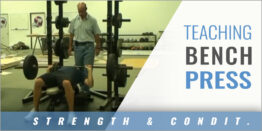|
Projected Maxes: A Safer Approach to Maxing Out by Boo Schexnayder
Projected Maxes Choosing the Test Weight The Test The Chart
Interpreting Results |
||||||||||||||||||||||||||
|
About the Author... |
|
|
| Irving "Boo" Schexnayder is regarded internationally as one of the leading authorities in training design. He, as co-founder of SAC brings 31 years of experience in the coaching and consulting fields to the organization.
Most noted for the 12 years he spent as a member of the Track and Field coaching staff at LSU. Schexnayder, who coached collegiately at Louisiana-Lafayette and Blinn Junior College prior to arriving at LSU, placed quite an imprint on the collegiate track and field scene. Regarded as one of the world's premier field event coaches, he was the mastermind behind 19 NCAA Champions during his collegiate coaching career. He was a part of 12 NCAA Championship teams and a pair of Juco National titles, as well as developing a host of conference champions and All-Americans. Schexnayder has also been a prominent figure on the international scene, having coached triple jumper Walter Davis to multiple World Championships, and long jumper John Moffitt to a silver medal at the 2004 Olympics in Athens. He also tutors former US Long Jump Champ Brian Johnson, Miguel Pate, ranked 6th in the world in 2008, and US Indoor Champ Jeremy Hicks. He has coached 10 Olympians, and has served on coaching staffs for Team USA to the 2003 Pan Am Games in Santo Domingo, the 2006 World Junior Championships in Beijing, and was the Jumps Coach for Team USA at the 2008 Olympics in Beijing. As impressive as Schexnayder's accomplishments are on the track, he has been just as successful off the track. He is certified at Level I, II and III, and owns the prestigious Master Coach Designation from USA Track and Field. He has formerly served as national chair of USATF's Coaching Education Committee, Jumps Subcommittee chair, and chair of the Biomechanics subcommittee. Schexnayder currently serves as the Chair of Advisory Board of the USTFCCCA Track and Field Academy, and directs its programs. An educator by profession and a mentor of hundreds of coaches, he has been very active in curriculum development for Coaching Education programs, and has lectured nationally and internationally on speed/power training programs, jumps and combined events training, biomechanics, and rehabilitation. He has authored several publications covering these topics. He has also been very active in the consulting field, working in NFL player development and combine prep from 2002 to the present, and consulting for individuals, high school programs, and collegiate programs in the areas of training design, jump improvement, speed training, rehabilitations, and specialized programs for football, basketball, soccer, and volleyball. Prior to his collegiate and international career, Schexnayder was a successful mathematics teacher and prep coach at St. James High School for 11 years, coaching football, track and field, and cross country. The Vacherie, La., native was class valedictorian at St. James High in 1979, and earned both his bachelor's and master's degrees at Nicholls State University. He graduated cum laude with a B.S. in physical education in 1983 and later added a master's degree in administration and supervision in 1988, again earning cum laude honors. |







